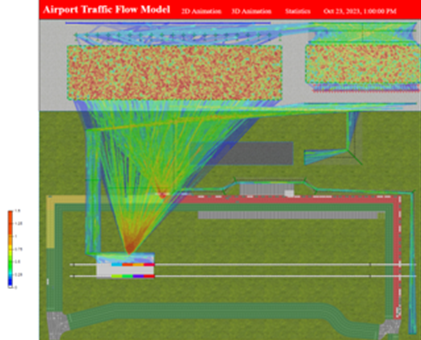Developing a conceptual simulation model to analyze and improve traffic flows of the multimodal terminal "RIX" and decision-making for the formation of a new transport hub
DOI:
https://doi.org/10.55225/sti.650Słowa kluczowe:
multimodality, hubs, RIX, Rail Baltica, passenger, traffic flows, conceptual simulation model, optimizationAbstrakt
The article explores the development of a simulation model as a decision support tool to aid the planning and development of a new multimodal transport hub at Riga International Airport (RIX), considering its integration with the Rail Baltica project. The study addresses the growing significance of multimodality in enhancing connectivity, passenger service quality, and infrastructure efficiency at major air transport hubs. The air transport system – comprising both demand-side (passengers, freight) and supply-side (airports, airlines, air traffic control) components - has long been affected by capacity constraints, congestion, and environmental issues. These challenges have persisted and, in some cases, intensified in the post-pandemic recovery period.
The aim of the study is to develop a conceptual simulation model that supports tactical decision-making for traffic flow optimization and infrastructure development at RIX. The research emphasizes complementary role of rail transport in multimodal integration, particularly its potential to extend air connectivity and enable seamless “door-to-door” travel chain. Best practices in multimodality at Helsinki and Singapore airports are reviewed. The current state of infrastructure and intermodal connectivity at RIX is analyzed, especially with reference to its future connection to the planned Rail Baltica line.
A holistic approach to service level analysis is applied, incorporating both terminal and regional access components. Given the complexity of such large-scale projects, modern model-based tools are essential for evaluating alternative scenarios and supporting planning decisions. The proposed conceptual simulation model provides a methodological framework for evaluating multimodal passenger flows and supports strategic decisions on hub development and infrastructure optimization.
Statystyka pobrań
Bibliografia
Rodrigue J-P, Comtois C, Slack B. The Geography of Transport Systems. Routledge; 2020. DOI: https://doi.org/10.4324/9780429346323 Google Scholar
Keeney RL, Raiffa H. Decisions with Multiple Objectives: Preferences and Value Trade-Offs. Cambridge University Press; 1993. DOI: https://doi.org/10.1017/CBO9781139174084 Google Scholar
Turban E, Sharda R, Delen D. Decision Support and Business Intelligence Systems. Pearson Education; 2014. Google Scholar
European Commission: White Paper: Roadmap to a Single European Transport Area – Towards a competitive and resource efficient transport system Brussels [Internet]. 2021 March 28 [cited 2024 Oct. 16]. Available from: https://eur-lex.europa.eu/legal-content/EN/TXT/?uri=celex:52011DC0144. Google Scholar
Ortuzar JD, Willumsen LG. Modelling Transport. John Willey & Sons; 2006. Google Scholar
Savrasovs M, Yatskiv I, Tolujevs Y, Jackson I. (2020), Simulation as a decision supporting tool for airport planning: Riga International Airport case study. Transport. 2021;36(6):474––485. https://doi.org/10.3846/transport.2021.16198. DOI: https://doi.org/10.3846/transport.2021.16198 Google Scholar
Rail Baltica. (2024). Ministry of Transport of the Republic of Latvia. Google Scholar
TVNET. Rail Baltica deadlines extended again: Latvia loses over €17 million in unused EU funding. 2024 [cited 2024 Dec. 12]. Available from: https://www.tvnet.lv/7998447/. Google Scholar

Pobrania
Opublikowane
Jak cytować
Numer
Dział
Licencja
Prawa autorskie (c) 2025 Sofija Kostina, Konstantins Savenkovs, Vladimirs Reiskarts

Utwór dostępny jest na licencji Creative Commons Uznanie autorstwa – Na tych samych warunkach 4.0 Miedzynarodowe.



